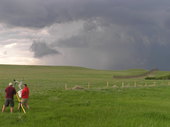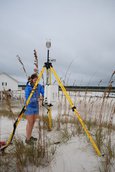Highlight
VORTEX2
Achievement/Results
The first phase of VORTEX 2 (Verification of the Origins of Rotation in Tornadoes EXperiment 2) began May 10, 2009 and lasted until June 15, 2009. The second phase of VORTEX2 began May 1st, 2010 and lasts until June 15, 2010. Texas Tech is one of many groups taking part in the multi-million dollar project funded by the NSF and NOAA. The goals of VORTEX 2 are to collect data from within a supercell thunderstorm, to better understand the near-storm environment and its effects on tornadogenesis. With this kind of understanding, scientists hope that they will be better able to forecast tornado occurrences, and improve warning times, so people have time to take shelter, and to decrease false alarm rates.
Texas Tech provided StickNets which served as the primary surface observing platforms for the project. The StickNet team strategies were virtually the same as in the 2006-2008 severe thunderstorm seasons. VORTEX 2 was the debut for the TTUKA-1 Mobile Radar Trucks, which were completed shortly before the project began. TTUKA-1 served as tornado-scale mobile radars for the project, and captured the evolution and vortex structure of the LaGrange, Wyoming tornado in 2009 and multiple tornados in 2010. Whenever possible, TTUKA-1 was located in the near vicinity of the StickNet arrays, so that it could scan over the arrays to capture the 3-dimensional data that was desired. The Texas Tech VORTEX 2 team featured many veteran researchers to lead the efforts.
All-in-all, two faculty members, one research faculty, and 14 graduate students from Texas Tech, along with six students from the University of Michigan, lent their time and efforts to make the project a success. Our TTU team consisted of the largest number of total students and the largest number of undergraduate students in the entire project.
VORTEX 2 proved to be a challenging and rewarding experience. The teams were on the road for almost 40 days in 2009 and 46 days in 2010, sharing hotels, eating fast food, driving hundreds of miles a day, being away from their friends, families, and daily lives, and putting their own research projects on hold to participate in this once-in-a-lifetime opportunity. Due to a slow storm season in 2009, only one tornado intercept was made, but despite the lack of tornadoes, the StickNet teams deployed 221 StickNet probes (including one 6-hour stint of 36 deployments!) for 25 storm events, many of which represented outstanding “null” cases.
In order to understand tornadoes better and improve warnings, we must understand why some storms produce tornadoes while other storms that appear to be the same do not, so the “null” cases are just as valuable as the tornadic case. The lone tornadic supercell occurred on June 5, 2009, near LaGrange, Wyoming, and was just what the project leaders were hoping for “slow-moving, long-lived, and in an unpopulated area” and we captured the entire storm, from beginning to end. Teams were in place as funnels emerged from the cloudbase three times before finally making contact with the ground creating a tornado. We made measurements until the tornado dissipated almost 30 minutes later. With all of the radars and instruments in place collecting data, this tornado is now the most documented tornado in history.
During VORTEX 2, several teams from The Weather Channel are embedded to document the project and educate the public about it. IGERT trainees and faculty from Texas Tech provided numerous interviews about the project, the instrumentation, and their specific missions and tasks. The Weather Channel also featured live footage of storm intercepts and deployments, which included a StickNet deployment on live television with the LaGrange tornado on the ground in the background of the shot. Please see the following links to view the videos featuring the Texas Tech team and their instruments.
- http://www.weather.com/multimedia/videoplayer.h...
- http://www.weather.com/multimedia/videoplayer.h...
- http://www.weather.com/multimedia/videoplayer.h...
- http://www.weather.com/multimedia/videoplayer.h...
- http://www.weather.com/multimedia/videoplayer.h...
- http://www.weather.com/multimedia/videoplayer.h...
- http://www.weather.com/multimedia/videoplayer.h...
- http://www.weather.com/multimedia/videoplayer.h...
- http://www.weather.com/multimedia/videoplayer.h...
- http://www.weather.com/multimedia/videoplayer.h...
- http://www.weather.com/multimedia/videoplayer.h...
Address Goals
The goals of VORTEX 2 are to collect data from within a supercell thunderstorm, to better understand the near-storm environment and its effects on tornadogenesis. With this kind of understanding, scientists hope that they will be better able to forecast tornado occurrences, and improve warning times, so people have time to take shelter, and to decrease false alarm rates.







